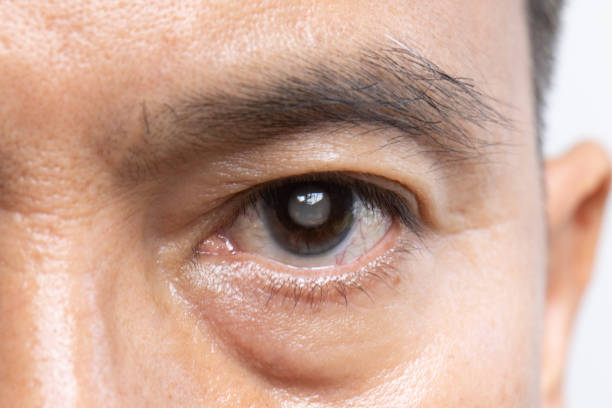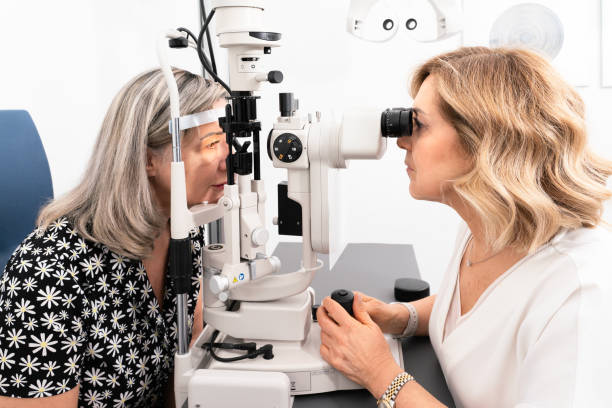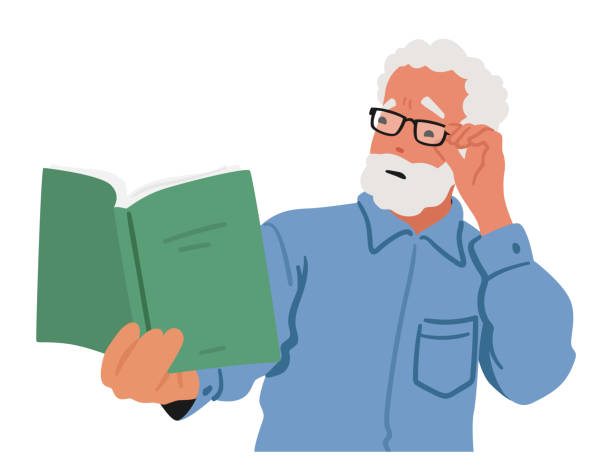As we age, our bodies go through many changes, and our eyes are no exception. Vision naturally changes over time, often leading to difficulties such as trouble reading small print, adjusting to different lighting conditions, or experiencing more dryness and irritation. However, this doesn’t mean you have to accept poor eyesight as an unavoidable part of aging.
By understanding the most common age-related vision changes—such as presbyopia, cataracts, and increased risk of eye diseases—you can take proactive steps to protect your eyes. Simple habits like regular eye exams, a nutrient-rich diet, and proper eye care can help maintain clear vision and overall eye health well into your later years.
In this blog post, we’ll cover the most common problems that come with aging, ways to prevent or slow these changes, and when to see an eye doctor. Whether you’re in your 40s, 50s, 60s, or beyond, this guide will help you take control of your eye health.
Common Age-Related Vision Changes
Many people notice differences in their eyesight as they get older. These changes often happen gradually, making them easy to ignore at first. Here are some of the most common age-related vision issues:
1. Presbyopia (Difficulty Seeing Up Close)
Presbyopia is the natural loss of near vision that comes with aging, typically becoming noticeable around the age of 40. You may find yourself holding books, menus, or your phone at arm’s length to see the text clearly, especially in dim lighting. This happens because the lens inside your eye gradually becomes less flexible, making it harder to focus on objects up close.
As this flexibility decreases, your eyes struggle to adjust between near and far distances as quickly as they once did. While presbyopia is a normal part of aging, solutions like reading glasses, bifocals, progressive lenses, or even contact lenses can help you see clearly and comfortably in your daily activities.
🔹 Symptoms: Holding books or menus at arm’s length, needing more light to read, eye strain when doing close-up tasks.
🔹 Solutions: Reading glasses, bifocals, progressive lenses, or contact lenses designed for presbyopia.
2. Dry Eyes
As we age, our eyes may produce fewer tears or lower-quality tears, leading to dryness, irritation, redness, and a gritty sensation. This condition, known as dry eye syndrome, can make activities like reading, using digital screens, or spending time in air-conditioned environments uncomfortable. It is especially common in postmenopausal women due to hormonal changes that affect tear production.
Other factors, such as certain medications, underlying health conditions, and environmental influences, can also contribute to dry eyes. Staying hydrated, using lubricating eye drops, and protecting your eyes from wind and harsh lighting can help manage symptoms and keep your eyes comfortable.
🔹 Symptoms: Burning, itching, redness, a gritty feeling, or watery eyes (as a response to dryness).
🔹 Solutions: Artificial tears, warm compresses, drinking more water, using a humidifier, and avoiding excessive screen time.
3. Cataracts (Cloudy Vision)

A cataract is a clouding of the eye’s natural lens that causes vision to become blurry, dull, or less vibrant. Colors may appear faded, glare from lights may seem more intense, and night vision can become increasingly difficult. Cataracts develop gradually over time as proteins in the lens break down and clump together, reducing the eye’s ability to focus light properly. They are very common in people over 60, and while they can affect one or both eyes, they do not spread from one eye to the other. In the early stages, stronger lighting, anti-glare glasses, or magnifying lenses may help improve vision.
However, as cataracts progress and begin to interfere with daily activities, surgery is a highly effective treatment. Cataract surgery involves replacing the cloudy lens with a clear artificial lens, restoring sharp vision and improving overall quality of life.
🔹 Symptoms: Blurry or hazy vision, glare or halos around lights, trouble seeing at night, and colors appearing faded.
🔹 Solutions: Early on, stronger glasses or better lighting may help. If cataracts interfere with daily life, surgery is the best option.
4. Glaucoma (Damage to the Optic Nerve)
Glaucoma is a group of eye diseases that can lead to gradual vision loss and, if left untreated, may result in permanent blindness. It occurs when fluid builds up in the eye, increasing intraocular pressure and damaging the optic nerve, which is responsible for transmitting visual information to the brain. In its early stages, glaucoma often has no noticeable symptoms, making regular eye exams essential for early detection.
As the condition progresses, it can cause peripheral vision loss, blind spots, and eventually tunnel vision. There are different types of glaucoma, with open-angle glaucoma being the most common. Risk factors include age, family history, diabetes, and high blood pressure. While there is no cure, treatments such as prescription eye drops, laser therapy, or surgery can help manage eye pressure and slow the progression of vision loss.
🔹 Symptoms: Often no symptoms in early stages, but later signs include peripheral (side) vision loss, tunnel vision, and blind spots.
🔹 Solutions: Regular eye exams to catch it early. Treatment includes prescription eye drops, laser therapy, or surgery.
5. Age-Related Macular Degeneration (AMD)
Age-related macular degeneration (AMD) is a progressive eye disease that affects the macula, the small but crucial part of the retina responsible for sharp central vision. Over time, AMD can make everyday tasks like reading, driving, and recognizing faces increasingly difficult.
There are two main types of AMD: dry AMD, which develops gradually as the macula thins with age, and wet AMD, a more severe form that occurs when abnormal blood vessels grow under the retina and leak fluid. While AMD does not cause complete blindness, it can significantly impact quality of life by reducing the ability to see fine details. Risk factors include aging, smoking, genetics, and prolonged exposure to ultraviolet (UV) light.
Although there is no cure, lifestyle changes such as eating a diet rich in antioxidants, quitting smoking, and protecting the eyes from UV rays can help slow its progression. In some cases, treatments like anti-VEGF injections or laser therapy can help manage wet AMD and preserve vision.
🔹 Symptoms: Blurred or distorted central vision, straight lines appearing wavy, and dark spots in vision.
🔹 Solutions: There is no cure, but treatments like anti-VEGF injections, dietary changes, and lifestyle adjustments can help slow progression.
6. Diabetic Retinopathy
People with diabetes are at risk for developing diabetic retinopathy, a serious eye condition that occurs when high blood sugar levels damage the tiny blood vessels in the retina, the light-sensitive tissue at the back of the eye. In the early stages, diabetic retinopathy may cause little to no symptoms, making regular eye exams crucial for early detection.
As the condition progresses, damaged blood vessels can leak fluid or blood, leading to blurry vision, dark spots (floaters), and, in severe cases, permanent vision loss. In advanced stages, new, fragile blood vessels may form and bleed into the eye, increasing the risk of retinal detachment and blindness.
Proper diabetes management—maintaining healthy blood sugar, blood pressure, and cholesterol levels—can help reduce the risk of diabetic retinopathy. Treatments such as laser therapy, anti-VEGF injections, or surgery may be necessary to prevent further damage and preserve vision.
🔹 Symptoms: Blurred vision, floaters, dark areas in vision, and trouble seeing colors.
🔹 Solutions: Keeping blood sugar levels under control, regular eye exams, and laser treatments if needed.
How to Protect Your Eyes as You Age
While some vision changes are inevitable, there are many things you can do to maintain good eye health.
1. Get Regular Eye Exams

Eye exams help catch problems early, often before symptoms appear. Most experts recommend:
- Every 2–4 years for adults in their 40s and 50s.
- Every 1–2 years for those 60 and older.
- More frequent exams if you have a family history of eye disease, diabetes, or high blood pressure.
2. Eat a Healthy Diet
Your diet plays a big role in eye health. Nutrients like vitamins A, C, and E, as well as zinc and omega-3 fatty acids, help keep eyes healthy.
✔ Best foods for eye health:
- Leafy greens (spinach, kale)
- Carrots and sweet potatoes
- Fish (salmon, tuna)
- Nuts and seeds
- Citrus fruits (oranges, lemons)
3. Wear Sunglasses

UV rays from the sun can damage your eyes and increase the risk of cataracts and macular degeneration. Wear sunglasses that block 100% of UVA and UVB rays whenever you’re outside.
4. Manage Screen Time
Many older adults spend hours looking at screens, which can lead to digital eye strain. Follow the 20-20-20 rule: Every 20 minutes, look at something 20 feet away for 20 seconds to reduce strain.
5. Stay Active
Exercise improves blood circulation, which helps keep your eyes healthy. It also reduces the risk of conditions like diabetes and high blood pressure, which can affect vision.
6. Quit Smoking

Smoking increases the risk of cataracts, macular degeneration, and other eye diseases. If you smoke, quitting can greatly improve your eye health.
7. Control Health Conditions
High blood pressure, diabetes, and high cholesterol can all affect vision. Managing these conditions with medication, diet, and exercise can help protect your eyesight.
When to See an Eye Doctor
See an eye doctor if you notice:
❌ Sudden vision loss or blurriness
❌ Flashes of light or new floaters
❌ Eye pain or redness
❌ Trouble seeing at night
❌ Difficulty reading or recognizing faces
Early detection is key to preventing serious vision loss. Even if you don’t have symptoms, regular eye exams can catch problems before they worsen.
Final Thoughts
Aging affects your vision in many ways, but it doesn’t have to mean losing your eyesight or giving up the activities you love. While conditions like presbyopia, cataracts, and age-related macular degeneration become more common with age, taking proactive steps can help preserve your eyesight and overall eye health.
By staying informed about potential vision changes, making healthy lifestyle choices—such as eating a nutrient-rich diet, protecting your eyes from UV light, and avoiding smoking—and seeing an eye doctor regularly for comprehensive exams, you can detect problems early and take action to slow their progression. Prioritizing eye health allows you to maintain clear vision, independence, and a high quality of life well into your later years.
👀 Take care of your eyes today, so they take care of you tomorrow! Do you have any eye health tips or experiences to share? Leave a comment below!

